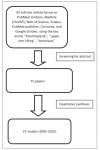Complications associated with brachioplasty: a literature review
- PMID: 29350652
- PMCID: PMC6166161
- DOI: 10.23750/abm.v88i4.5609
Complications associated with brachioplasty: a literature review
Abstract
Background: Paralleling the growth of bariatric surgery, the demand for post-bariatric body-contouring surgery is increasing. Weight loss is the main cause, although not the only one, that drives patients to arm lift surgery. Several surgical techniques have been proposed over the years. Our aim was to consider the complications and outcomes according to the performed technique, through a wide review of the literature.
Methods: A search on PubMed/Medline was performed using "brachioplasty", "upper arm lifting", and "techniques" as key words. Embase, Medline (OvidSP), Web of Science, Scopus, PubMed publisher, Cochrane, and Google Scholar were searched as well. As inclusion criteria, we selected the clinical studies describing techniques of brachioplasty. We excluded the papers in which complications related to brachioplasty were not specified. We also excluded literature-review articles.
Results: We found 27 studies from 1995 to 2015. Overall, 1065 patients were treated. Different techniques were applied. Complications were observed in 308/1065 patients (28.9%). The most frequent complications were hypertrophic scarring, seroma and hematoma. Surgical revision rate ranged from 0 to 21 percent. Nerve damage occurred in a modest percentage of patients (16/1065, 1.5%). No major complications, such as thromboembolism and sepsis, were observed.
Conclusions: Brachioplasty is a safe surgical procedure. All the brachioplasty techniques showed positive outcomes, in term of patients' satisfaction and clinical results. Nevertheless, minor complications occurred in a high percentage of patients, regardless the performed surgical procedure. Patients should be informed about the possible formation of hypertrophic scars and nerve injuries.
Keywords: Arm lifting; Body contouring surgery; Brachioplasty; Upper arm deformities.
Figures






References
-
- El Khatib HA. Classification of brachial ptosis: strategy for treatment. Plastic and reconstructive surgery. 2007;119:1337–42. - PubMed
-
- Thorek M. Esthetic surgery of the pendulous breast, abdomen and arms in females. Illinois Medical Journal. 1930;3:48–57.
-
- Shermak MA. Aesthetic refinements in body contouring in the massive weight loss patient: Part 2. Arms. Plastic and reconstructive surgery. 2014;134:726e–35e. - PubMed
-
- Posse P. Buenos Aires: Athenue; 1943. Cirurgia Estetica.
-
- Correa-Iturraspe M FJ. Dermatolipectomia braquial. Prensa Med Argent. 1954:2432. - PubMed
Publication types
MeSH terms
LinkOut - more resources
Full Text Sources
Medical
Research Materials

